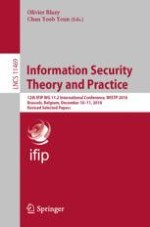2019 | OriginalPaper | Buchkapitel
Deep Learning Application in Security and Privacy – Theory and Practice: A Position Paper
verfasst von : Julia A. Meister, Raja Naeem Akram, Konstantinos Markantonakis
Erschienen in: Information Security Theory and Practice
Aktivieren Sie unsere intelligente Suche, um passende Fachinhalte oder Patente zu finden.
Wählen Sie Textabschnitte aus um mit Künstlicher Intelligenz passenden Patente zu finden. powered by
Markieren Sie Textabschnitte, um KI-gestützt weitere passende Inhalte zu finden. powered by
